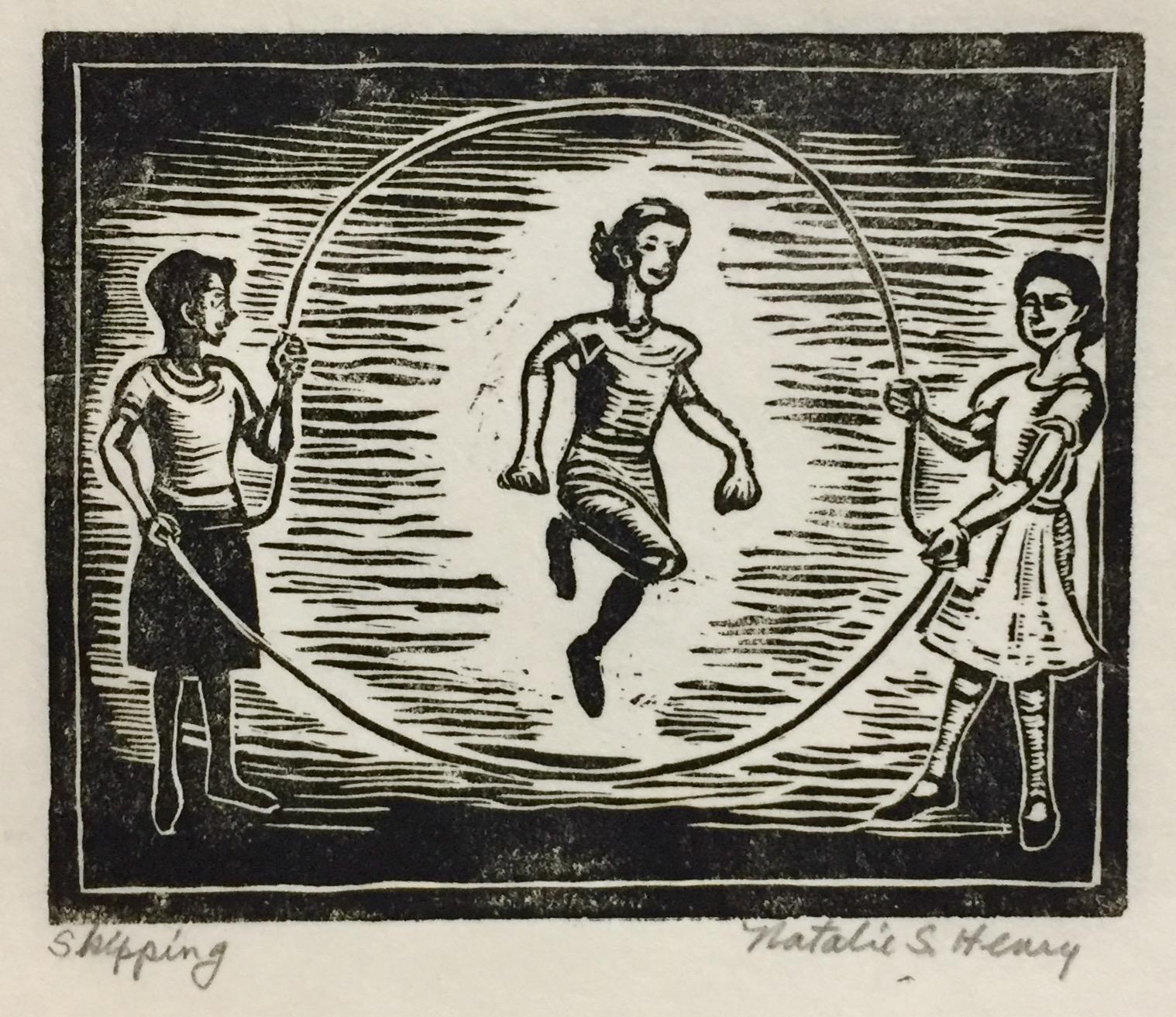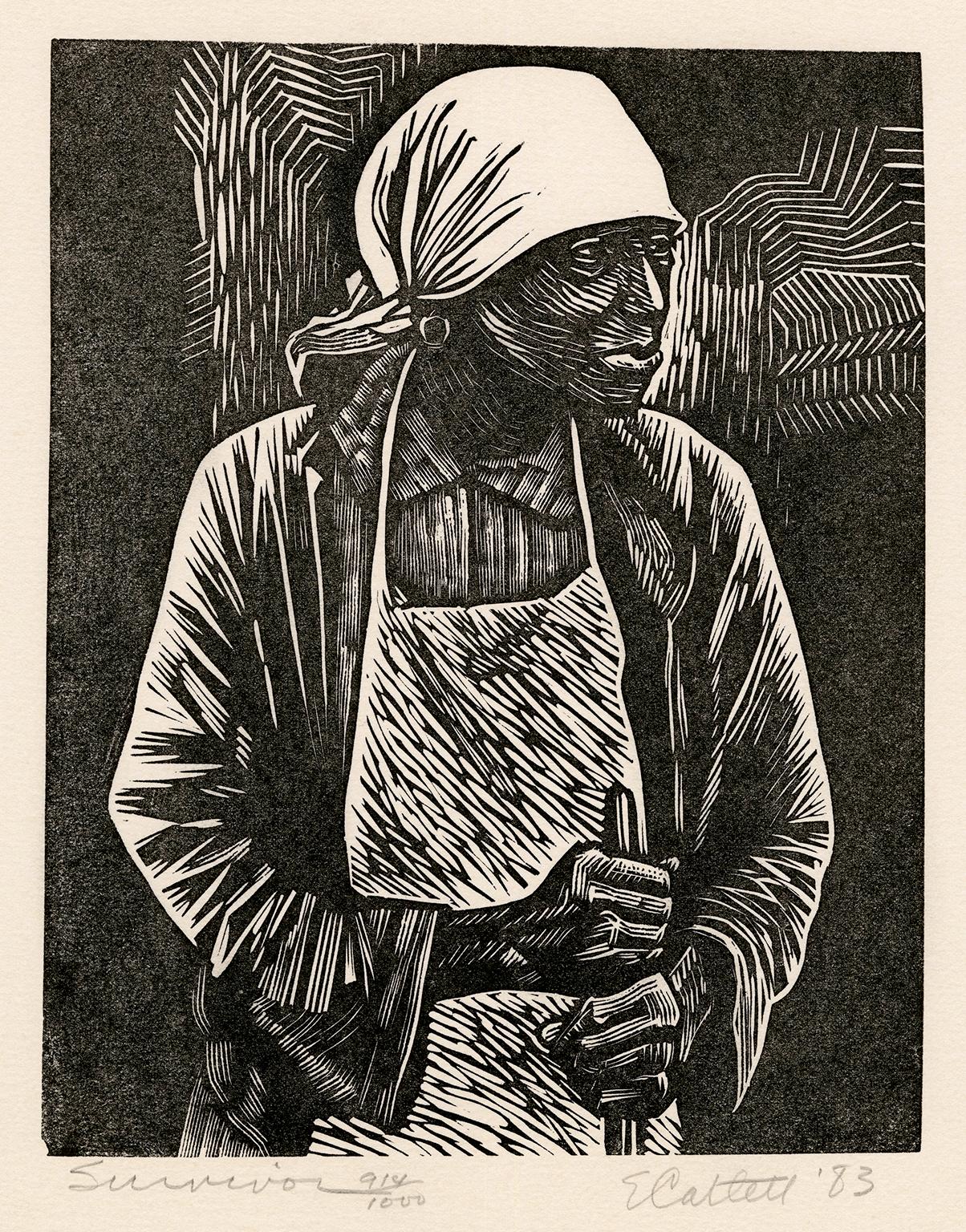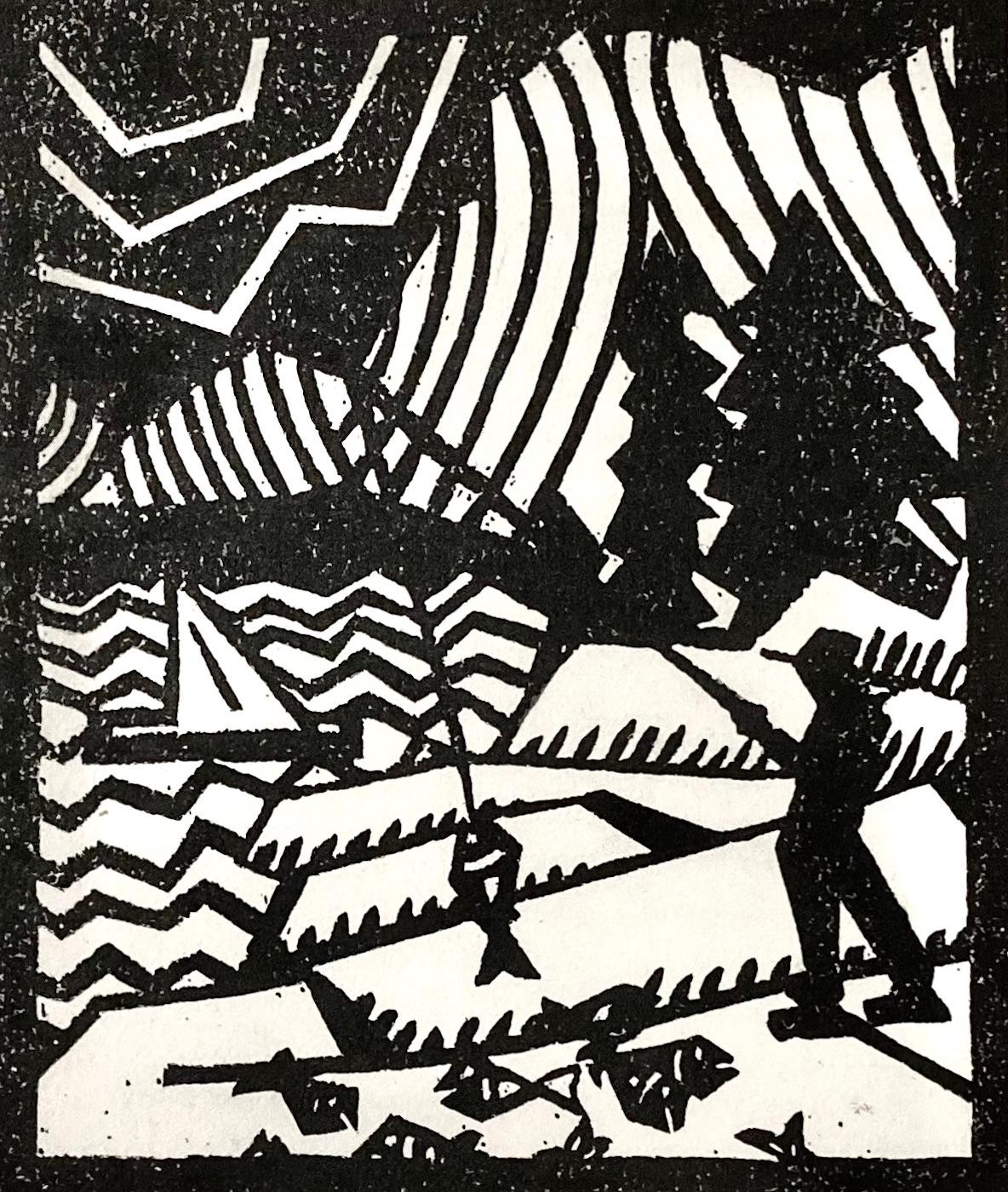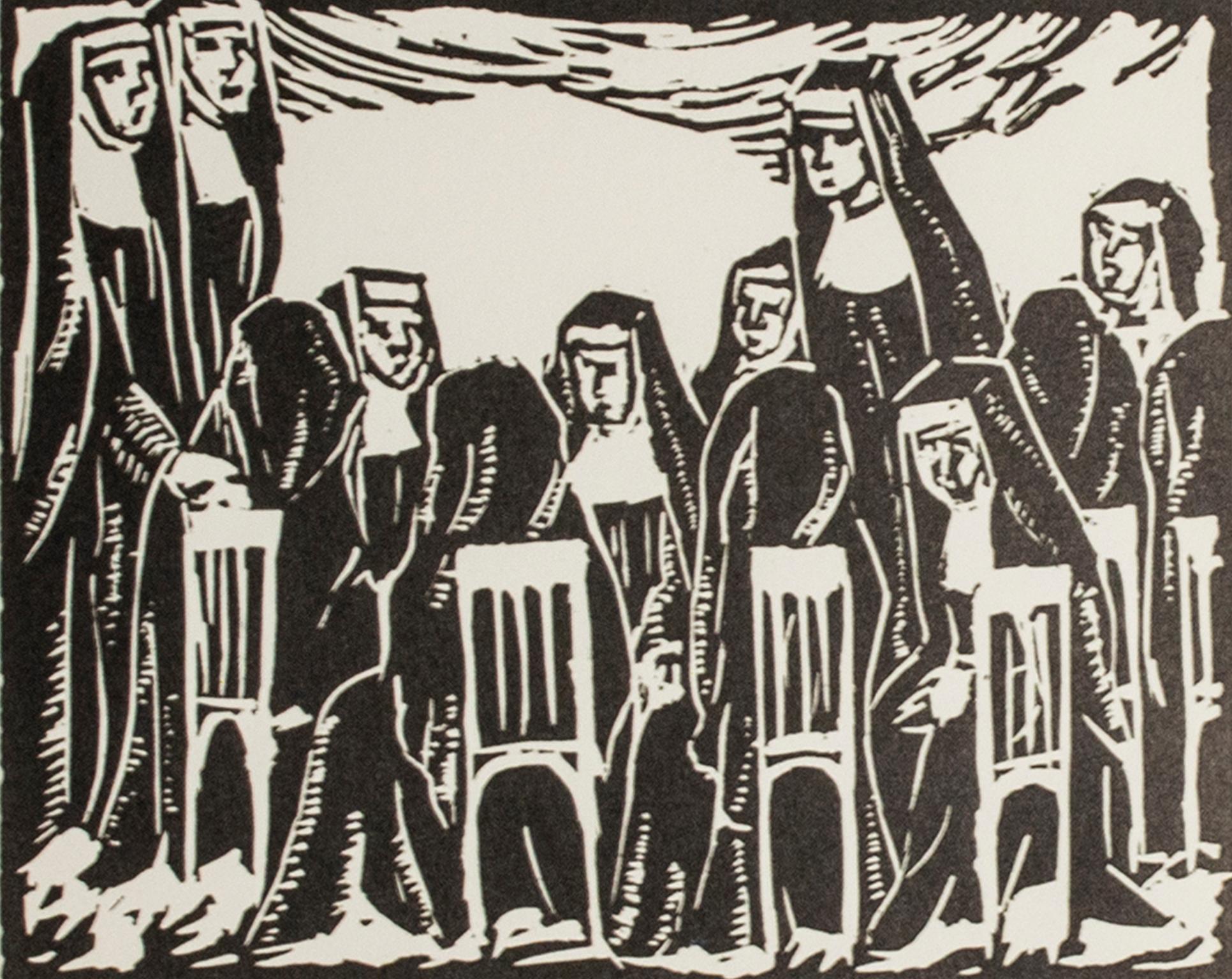Items Similar to Harbor with Sailboats — Early 20th-Century Modernism
Want more images or videos?
Request additional images or videos from the seller
1 of 3
George JosimovichHarbor with Sailboats — Early 20th-Century Modernism1923
1923
About the Item
George Josimovich, Untitled (Harbor with Sailboats) ', linocut, 1923, edition 35. Signed, dated, and annotated '4/35' in pencil. Initialed 'G J' in the matrix, lower left. A fine, richly-inked impression, on cream wove Japan paper, with full margins (7/8 to 2 3/4 inches), in excellent condition. Scarce. Image size 9 x 8 inches (225 x 203 mm); sheet size 14 1/2 x 10 3/4 inches (368 x 273 mm). Matted to museum standards, unframed.
“Life is in a constant state of flux-never-ceasing motion. Everything breathes, moves, vibrates. And it is my ardent belief that the same should be true in a work of art. It should be alive, dynamically alive. Every part of it should live and every part of it should contribute life to the creation as a whole. ...anyone who is sensitive and creative enough to deserve to be called an artist will consciously or unconsciously react to...those phases of life with which his particular nature and personality have a special kinship. And all this cannot help but leave an impress upon his work which is and must be, if it is sincere, an objective manifestation of his inner self.” —George Josimovich, Illinois Historical Art Project
ABOUT THE ARTIST
Born in Mitrovica, Yugoslavia (present-day Serbia), George Josimovich (1894 - 1986) immigrated to the United States with his parents and three younger brothers in 1908. The family settled in Fort Laramie and Cheyenne, Wyoming, along the Union Pacific Railroad, where his father worked as a tailor. In 1914, motivated by a newspaper advertisement for the Lockwood Art School in Kalamazoo, Michigan, Josimovich set out for the Midwest to pursue a career in art.
From 1914–19 he studied at the School of the Art Institute of Chicago (SAIC) under Karl Buehr and Randall Davey, and alongside fellow students William Schwartz, Emil Armin, and Archibald J. Motley Jr. During his final year at SAIC, Josimovich enrolled in a life class with visiting professor George Bellows, whose teachings about avant-garde art, geometric composition, color theory, and individualism in art exerted a profound influence. An exhibition of applied arts by German artist Hermann Sachs at the Art Institute of Chicago during the winter of 1920–21 also made a strong impression on the young artist. Josimovich studied under Sachs at Chicago’s Hull House and, along with other former SAIC students, followed Sachs to the Dayton Art Museum in Ohio to establish an expressionist craft program.
Josimovich returned to Chicago in 1922, where he joined the Jackson Park art colony and spent the next four years honing his craft and developing theories on composition and form. His works from this period evince a lively experimentation with modernist principles and techniques in oil and watercolor paintings, prints, and drawings. Familiar genres of figure study, still life, and landscape are distilled into abstract arrangements of fragmented forms in radically flattened pictorial space, often within tightly ordered geometric compositions. Throughout the 1920s Josimovich established himself as a leading contemporary artist in the city, exhibiting with the Chicago No-Jury Society of Artists, The Ten, and the Chicago Society of Artists, where he later served as president. Critics lauded him as quintessentially modern, praising his “rigid intellectualism” and his focus on color, form, and movement. Josimovich’s year in Paris in 1926–27, where he encountered other practitioners of abstraction and the theory of purism, further stimulated his modernist approach to art. His French sojourn culminated in a 1927 solo exhibition at the Galerie d’art contemporain in Paris, which garnered much coverage in the press.
In the 1930s, Josimovich dramatically transformed his art and became an expressionist in the vein of French painter Chaim Soutine. Soutine, who had emigrated to Paris in 1913 from Belarus, rose to international prominence through a major show at the gallery of Paul Guillaume in 1923 and subsequent purchases of his work by American collector Albert Barnes. Josimovich’s portraits, still lifes, and landscapes from this period bear some of the hallmarks of Soutine’s work in their exaggerated figures, quivering masses of color, and dynamic brushstrokes, and as a result, sparked strongly divided commentary among Chicago critics.
In the early 1930s, Josimovich was one of the organizers of the Fifty-seventh Street Art Colony, a group of artists with modernist sympathies, and worked briefly for the artists’ relief program of the Works Progress Administration. He continued to show his work through the 1950s in numerous group exhibitions at the Art Institute of Chicago, with the No-Jury Society of Artists and the Chicago Society of Artists, and in a solo exhibition at Knoedler’s Chicago gallery in 1932.
—edited from an essay by Patricia Smith Scanlan for ‘Modernism in the New City, Chicago Artists, 1920-1950’
- Creator:George Josimovich (1894 - 1986)
- Creation Year:1923
- Dimensions:Height: 9 in (22.86 cm)Width: 8 in (20.32 cm)
- Medium:
- Movement & Style:
- Period:
- Condition:
- Gallery Location:Myrtle Beach, SC
- Reference Number:
About the Seller
5.0
Recognized Seller
These prestigious sellers are industry leaders and represent the highest echelon for item quality and design.
Platinum Seller
These expertly vetted sellers are 1stDibs' most experienced sellers and are rated highest by our customers.
Established in 1995
1stDibs seller since 2016
259 sales on 1stDibs
Typical response time: 1 hour
Associations
International Fine Print Dealers Association
- ShippingRetrieving quote...Ships From: Myrtle Beach, SC
- Return PolicyA return for this item may be initiated within 7 days of delivery.
More From This SellerView All
- 'Survivor' — Elizabeth CatlettBy Elizabeth CatlettLocated in Myrtle Beach, SCElizabeth Catlett, 'Survivor', linocut, 1983, edition 1000. Signed, titled, dated, and numbered '914/1000' in pencil. A fine impression, on...Category
1980s American Modern Figurative Prints
MaterialsLinocut
- 'Commuters' — Early 20th-Century ModernismBy George JosimovichLocated in Myrtle Beach, SCGeorge Josimovich, 'Commuters', linocut, 1922-23, edition 20. Signed, dated '22, titled, and annotated '9/20' in pencil. Initialed in the block 'G.J....Category
1920s American Modern Figurative Prints
MaterialsLinocut
- Unemployed Marchers — 1930s Modernism, WPABy Leon BibelLocated in Myrtle Beach, SCLeon Bibel, 'Unemployed Marchers', 2-color lithograph, c. 1938, edition 25. Signed, titled, and numbered '2/25' in pencil. A fine, richly-inked impression, on off-white wove paper, w...Category
1930s American Modern Figurative Prints
MaterialsLithograph
- 'After the Start' — America's Cup, 1893By Jacques La GrangeLocated in Myrtle Beach, SCJacques La Grange, 'After the Start', color woodcut, edition 500, 1934. Signed and numbered '25/500' in pencil. A fine impression, with fresh colors, on cream wove paper, with margins (1 1/4 to 1 5/8 inches), in excellent condition. Archivally matted to museum standards, unframed. A work from La Grange’s celebrated series of woodcuts 'Drama and Color in the America's Cup Races'. Image size 9 5/8 x 12 1/8 inches (244 x 384 mm); sheet size 12 1/4 x 15 1/8 inches (311 x 384 mm). ABOUT THE ARTIST Jacques La Grange was born in Clanwilliam (near Cape Town) in South Africa in 1895. He studied at London University and later immigrated to the United States. La Grange established himself as a painter, illustrator, and printmaker specializing in nautical subjects. He and his wife, Helen La Grange, published 'Drama and Color in the America's Cup Races' in 1934 and 'Clipper Ships of America and Great Britain 1833-1869', in 1936. Both were deluxe hardcover limited edition volumes with signed original color woodblock prints. La Grange had solo exhibitions at the Buchanan Gallery in 1929, the Babcock Gallery and the 56th Street Gallery in New York in 1930, and at the Nicholas Roerich...Category
1930s American Modern Figurative Prints
MaterialsWoodcut
- 'The Yankee' — America's Cup, 1934By Jacques La GrangeLocated in Myrtle Beach, SCJacques La Grange, 'The Yankee', color woodcut, edition 500, 1934. Signed and numbered '25/500' in pencil. A fine impression, with fresh colors, on cream wove paper, with margins (1 1/8 to 1 1/4 inches), in excellent condition. A work from La Grange’s celebrated series of woodcuts 'Drama and Color in the America's Cup Races'. Image size 10 x 10 11/16 inches (254 x 271 mm); sheet size 12 1/4 x 13 1/4 inches (311 x 337 mm). Archivally matted to museum standards, unframed. When the artist created this print in 1934, the 'Yankee' was one of the most promising yachts eligible for the America's Cup but ultimately 'Rainbow' was chosen to defend against England's 'Endeavor' in that year's race. The 'Endeavor' was built for Thomas Sopwith who used his aviation design expertise to ensure the yacht was the most advanced of its day with a steel hull and mast. She was launched in 1934 and won many races in her first season but the Cup challenge was blighted by a strike of Sopwith's professional crew prior to departing for America. Forced to rely mainly on keen amateurs, who lacked the necessary experience, the campaign failed. 'Rainbow' won the series 4–2. This was one of the most contentious of the America's Cup battles and prompted the headline "Britannia rules the waves and America waives the rules." ABOUT THE ARTIST Jacques La Grange was born in Clanwilliam (near Cape Town) in South Africa in 1895. He studied at London University and later immigrated to the United States. La Grange established himself as a painter, illustrator, and printmaker specializing in nautical subjects. He and his wife, Helen La Grange, published 'Drama and Color in the America's Cup Races' in 1934 and 'Clipper Ships of America and Great Britain 1833-1869', in 1936. Both were deluxe hardcover limited edition volumes with signed original color woodblock prints. La Grange had solo exhibitions at the Buchanan Gallery in 1929; the Babcock Gallery and the 56th Street Gallery, New York, in 1930; and at the Nicholas Roerich...Category
1930s American Modern Figurative Prints
MaterialsWoodcut
- 'Eyes for the Night' — Mid-century ModernismBy Benton Murdoch SpruanceLocated in Myrtle Beach, SC'Eyes for the Night', color lithograph, 1948, edition 35, Fine and Looney 261. Signed, dated, and titled, and annotated 'Ed 35' in pencil. A fine impression with fresh colors, on c...Category
1940s American Modern Figurative Prints
MaterialsLithograph
You May Also Like
- Natalie S. Henry, Skipping (Children Skipping Rope)Located in New York, NYSigned and titled in pencil. Henry is known for her images of children and her Chicago environment. She frequently showed with the Chicago Society of Artists.Category
1920s American Modern Figurative Prints
MaterialsLinocut
- Martha Reed, (Fishing)By Martha ReedLocated in New York, NYMartha Reed was the daughter of the artist Doel Reed and as an adult she joined her parents in Taos, New Mexico. There she designed clothes with a south-we...Category
Mid-20th Century American Modern Abstract Prints
MaterialsLinocut
- "Swimmers, " Seascape Linoleum Cut by Clarice George LoganBy Clarice George LoganLocated in Milwaukee, WI"Swimmers" is an original linoleum print by Clarice George Logan. It features five figures enjoying a swim, jumping off from a small boat. Image: 4.94" x 6" Framed: 13.87" x 14.87" Clarice George Logan was born in Mayville, New York in 1909 but moved to Wisconsin in 1921. She attended the Milwaukee State Teachers College from 1927 to 1931 where she studied with Robert von Neumann...Category
1930s American Modern Figurative Prints
MaterialsLinocut
- "Sisters, " Portrait of Nuns Linoleum Cut by Hulda Rotier FischerLocated in Milwaukee, WI"Sisters" is an original linoleum print by Hulda Rotier Fisher. It features a gathering of nuns. Image: 4" x 5" Framed: 12.12" x 13.12" Hulda Rotier Fischer was a well know Milwaukee, Wisconsin artist and teacher, exhibiting widely from the 1930’s well into the 1950’s. Fischer studied at the Milwaukee Normal School under Robert Von Neumann...Category
1930s American Modern Figurative Prints
MaterialsLinocut
- Reclining NudeBy Irene ZevonLocated in Buffalo, NYAn original linocut print by American artist Irene Zevon. The reclining nude is one of Zevon's most coveted subject matters. This 1959 print is one of a series of ten prints.Category
1950s American Modern Figurative Prints
MaterialsPaper, Linocut
- ManBy Elizabeth CatlettLocated in Missouri, MOElizabeth Catlett “Man” 1975 (The Print Club of Cleveland Publication Number 83, 2005) Woodcut and Color Linocut Printed in 2003 at JK Fine Art Editions Co., Union City, New Jersey Signed and Dated By The Artist Lower Right Titled Lower Left Ed. of 250 Image Size: approx 18 x 12 inches Elizabeth Catlett (1915-2012) is regarded as one of the most important women artists and African American artists of our time. She believed art could affect social change and that she should be an agent for that change: “I have always wanted my art to service black people—to reflect us, to relate to us, to stimulate us, to make us aware of our potential.” As an artist and an activist, Catlett highlighted the dignity and courage of motherhood, poverty, and the working class, returning again and again to the subject she understood best—African American women. The work below, entitled, “Man”, is "carved from a block of wood, chiseled like a relief. Catlett, a sculptor as well as a printmaker, carves figures out of wood, and so is extremely familiar with this material. For ‘Man’ she exploits the grain of the wood, allowing to to describe the texture of the skin and form vertical striations, almost scarring the image. Below this intense, three-dimensional visage parades seven boys, printed repetitively from a single linoleum block in a “rainbow roll” that changes from gold to brown. This row of brightly colored figures with bare feet, flat like a string of paper dolls, raise their arms toward the powerful depiction of the troubled man above.” Biography: Elizabeth Catlett (1915-2012) Known for abstract sculpture in bronze and marble as well as prints and paintings, particularly depicting the female figure, Elizabeth Catlett is unique for distilling African American, Native American, and Mexican art in her work. She is "considered by many to be the greatest American black sculptor". . .(Rubinstein 320) Catlett was born in Washington D.C. and later became a Mexican citizen, residing in Cuernavaca Morelos, Mexico. She spent the last 35 years of her life in Mexico. Her father, a math teacher at Tuskegee Institute in Alabama, died before she was born, but the family, including her working mother, lived in the relatively commodious home of his family in DC. Catlett received a Bachelor of Arts degree from Howard University, where there was much discussion about whether or not black artists should depict their own heritage or embrace European modernism. She earned a Master of Fine Arts degree in 1940 from the University of Iowa, where she had gone to study with Grant Wood, Regionalist* painter. His teaching dictum was "paint what you know best," and this advice set her on the path of dealing with her own background. She credits Wood with excellent teaching and deep concern for his students, but she had a problem during that time of taking classes from him because black students were not allowed housing in the University's dormitories. Following graduation in 1940, she became Chair of the Art Department at Dillard University in New Orleans. There she successfully lobbied for life classes with nude models, and gained museum admission to black students at a local museum that to that point, had banned their entrance. That same year, her painting Mother and Child, depicting African-American figures won her much recognition. From 1944 to 1946, she taught at the George Washington Carver School, an alternative community school in Harlem that provided instruction for working men and women of the city. From her experiences with these people, she did a series of paintings, prints, and sculptures with the theme "I Am a Negro Woman." In 1946, she received a Rosenwald Fellowship*, and she and her artist husband, Charles White, traveled to Mexico where she became interested in the Mexican working classes. In 1947, she settled permanently in Mexico where she, divorced from White, married artist Francisco Mora...Category
Late 19th Century American Modern Figurative Prints
MaterialsWoodcut, Linocut
Recently Viewed
View AllMore Ways To Browse
1930s Modernism
Antique Sailboats
1920 Program
George Bellows Artists
Chicago Railroad
Antique Railroad Signs
Sailboat Set
Oil Painting Serbia
Antique Japanese Divider
Antique French Abstract Oil
Antique Ohio State
Hallmark Jr
J Schwartz
Union Pacific Railroad
Archibald Motley
Dayton Railroad
Ink Drawings If Paris City Streets
Vintage Foster Grants




